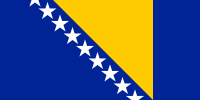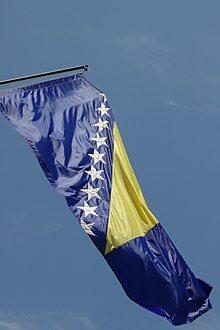Flag of Bosnia and Herzegovina
| Flag of Bosnia and Herzegovina | |
|---|---|
 |
|
| Vexillological symbol : |
|
| Aspect ratio: | 1: 2 |
| Officially accepted: | February 4, 1998 |
The national flag of Bosnia and Herzegovina was adopted on February 4, 1998. The flag's designer is Mladen Kolobarić , who was the head of the so-called Westendorp Commission for the redesign of the flag. Carlos Westendorp was the High Representative for Bosnia and Herzegovina from 1997 to 1999 .
Description and meaning
The flag shows a gold triangle against a blue background. A chain of white, five-pointed stars, imagined as an infinite, runs along the lower edge of the triangle.
The triangle symbolizes the geographical outline of Bosnia and Herzegovina and at the same time stands for the three ethnic groups in the country. The color yellow stands for peace and the sun. The blue color and the stars symbolize Europe. There are also some unofficial interpretations of the flag.
Colours
| system | blue | yellow | White |
|---|---|---|---|
| RGB | 0-35-149 | 254-203-0 | 255-255-255 |
| Hexadecimal color definition | # 002395 | # FECB00 | #FFFFFF |
history
In the archives in Mostar there is a flag from 1760, which was mainly used by landowners in western Herzegovina during the war. The green swallowtail flag shows a white, narrow crescent moon with a white, eight-pointed star.
After the Ottoman troops withdrew , Bosnia was de facto independent for a few months. During this time, a similar flag was used, as already used by Hussein Kapetan Gradaščević during the revolution of 1831/32: a green flag with a golden crescent moon and star.
In 1878 Bosnia and Herzegovina came under the rule of Austria-Hungary . Initially, the territory did not belong to either of the two parts of Austria and Hungary . Therefore, it received its own flag: a horizontal bicolor in red and yellow with the coat of arms of the territory, which was taken over by Hrvoje Vukčić Hrvatinić from the 14th century . In 1908 it was annexed by Austria and Bosnia used the bicolor red and yellow as the national colors, while Herzegovina used yellow and red.
 ? Bosnia under the sovereignty of Austria-Hungary, 1878 to 1908
? Bosnia under the sovereignty of Austria-Hungary, 1878 to 1908
 ? Bosnia after the annexation, 1908 to 1918
? Bosnia after the annexation, 1908 to 1918
 ? Herzegovina after annexation, 1908 to 1918
? Herzegovina after annexation, 1908 to 1918
On December 31, 1946, Bosnia and Herzegovina as a republic of socialist Yugoslavia received a red flag with the Yugoslav state flag as a Gösch . Red symbolizes communism.
When Bosnia and Herzegovina became independent in 1992, a white flag was introduced with the coat of arms of the House of Kotromanić in the middle. It represents a symbol of the Bosnian kingdom before the conquest of the country by the Ottomans. With independence in 1992, this coat of arms in the national flag was supposed to remind of Bosnia's independence and heyday in the Middle Ages. Although a new national flag was introduced after the Bosnian War in 1998, this flag is still used by many Bosnians, so it is often seen by fans at sporting events of the Bosnian national teams. Today the coat of arms with the six lilies is unofficially a symbol for the Bosniaks. Such a coat of arms can also be found on the Bosniaks living in Serbia and Montenegro , who have had their own flag for the Sandžak since 2004 , which was largely constructed based on this flag.
1: 2 ? Proposal from 1946, strongly reminiscent of the flag of Yugoslavia from 1945 to 1992

1: 2 ? Proposal from 1947

1: 2 ? Socialist Republic of Bosnia and Herzegovina, 1946-1991

1: 2 ? Flag used by many Muslim military units during the Bosnian War

1: 2 ? Republic of Bosnia and Herzegovina , 1992-1998

There were several proposals for the redesign of the national flags. Including a version based on the Czech flag that was supposed to represent the three ethnic groups in the country. Further suggestions were based on the flag of the United Nations . A golden olive branch or the outline of Bosnia and Herzegovina was proposed on a light blue background. Further suggestions show a diagonal striped tricolor in the colors red-white-blue. In the central white stripe, a map of the country surrounded by ten or twelve five-pointed yellow stars was intended. The results of the Westendorp Commission comprised three proposals. The first is essentially the same as today's flag, but uses a lighter blue based on the color of the United Nations. The other two variants have a different number of white and yellow horizontal stripes on a light blue background.
1: 2 ? Proposal based on the Czech model

1: 2 ? Variant based on the flag of the United Nations

1: 2 ? Variant with a white country outline

1: 2 ? Tricolor with ten stars

1: 2 ? Tricolor with twelve stars

1: 2 ? First Westendorp proposal

1: 2 ? Second Westendorp proposal

1: 2 ? Third Westendorp proposal

Subnational flags
- Entities
The Republika Srpska has its own flags, which bear no resemblance to the flag of the entire state. The flag for the Federation of Bosnia and Herzegovina was abolished on June 14, 2007 and has not yet been replaced by a new one.
Main articles: Flag of the Federation of Bosnia and Herzegovina , flag of the Republika Srpska
 ? Flag of the Federation of Bosnia and Herzegovina, 1996 to 2007
? Flag of the Federation of Bosnia and Herzegovina, 1996 to 2007
- Cantons
The cantons of the Federation of Bosnia and Herzegovina and municipalities in the country also have their own flags.

- cities and communes
Ethnic flags
Since Bosnia and Herzegovina is a nation state with three constituent peoples, some national flags are also represented in the country. However, these do not necessarily have to be an officially recognized symbol.
The so-called " lily flag " of the former Republic of Bosnia and Herzegovina is now a very popular national symbol of Bosnian Muslims
Unofficial flag of the Bosnian Muslims , often seen at mosques, rarely hoisted by the people
The flag of the Republika Srpska is also the symbol of the Serbs in Bosnia and Herzegovina
The flag of the former Croatian Republic of Herceg-Bosna is now the symbol of the Croats in Bosnia and Herzegovina
See also
literature
- Pål Kolstø: National symbols in new states . In: Eastern Europe . No. 7 , July 2003, ISSN 0030-6428 , Bosnia-Hercegovina: An artificial flag for an artificial state ?, p. 1002-1005 .
Web links
- Flags of the World - Bosnia and Herzegovina (English)
- Spirit of Bosnia On the origin of the Bosnian lily
Individual evidence
- ^ A b Republic of Bosnia and Herzegovina (Socialist Yugoslavia) , crwflags.com, Retrieved April 28, 2019
- ^ Pål Kolstø: National symbols in new states . In: Eastern Europe . No. 7 , July 2003, ISSN 0030-6428 , Bosnia-Hercegovina: An artificial flag for an artificial state ?, p. 1002 (Fig. 41) .






































